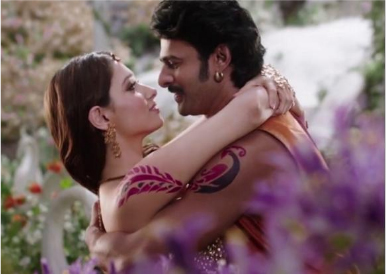Baahubali The Beginning - Female Domestication or Love?

Romance in Baahubali: The Beginning:
Female Domestication or Love?
Movie was good. But did it deserve a National Award?
By Sindhu Ravuri
A chipped, mahogany battle mask falls over the edge of a towering waterfall, inspiring Shiva to pursue the maiden behind it. Soon, in the ancient (6th century) city of Mahishmati, he discovers her – a highly trained female warrior named Avantika. He waits until she immerses her hand in a cool pond, and, unbeknownst to her, paints a beautiful lavender design upon her fingers and wrist, as if marking his territory. Later, he surreptitiously places a venomous snake upon her neck, intimidating her long enough for him to tattoo her once again on the shoulder.
When she finally confronts Shiva, to her a complete stranger, Avantika ferociously plunges into his heart, only to, despite her proficiency in guerrilla warfare, repeatedly miss the mark. Subsequently Shiva, a villager with no previous experience in combat, manages to sneak behind her and rip off her shirtsleeves. Then he, with a mischievous, charming grin, disentangles the strings of her armor in one graceful gesture – leaving her upper body mostly naked – removes the tie in her hair, douses her bare body in water, and forcibly smears squashed red berries upon her lips (like lipstick) and black berries upon the edges of her eyes (like kajal). Finally, he unravels her pants until they form a skirt. Thus, Shiva molds Avantika into the quintessential model of feminine splendor. She glances at her unfamiliar reflection in a nearby sheet of water, and, overwhelmed at her unleashed femininity, embraces Shiva in an expression of true love.
Shiva’s effusive persona and seductive dance with Avantika commands this scene from Baahubali: The Beginning, a Bollywood film internationally released this past July. The dulcet background score of the violin and flute, accompanied by lush, green scenery also frame this scene in an ethos of passion. This scene’s expert manipulation of visual and auditory aesthetics and its pronounced consistency with the quintessential Bollywood love story (involving an initially unwilling woman and a devoted, unrelenting man),presents it as an innocuous moment of romance, cloaking any obvious devices of subjugation. In fact, the scene’s portrayal of romance may even be progressive relative to past Indian cinema due its female character’s status as a fierce, independent warrior.
Most critics and audience members, including at first myself, would label the battle between these two characters as an intense or passionate love (proven by the YouTube title of the scene). In fact, Baahubali not only garnered widespread critical acclaim, but also became the third highest grossing Indian film globally of all time, indicating major audience approval of the work’s content.
However, I believe that there is indeed a strong correlation between gender inequity, specifically female domestication, and romance within Baahubali, going even so far as to say the presented scene constitutes an immensely aestheticized sexual assault, which in itself insists that true love necessitates the nonconsensual exposure of a woman and her vulnerability.
Avantika’s attire, including padded leather war gear and pants, are physical manifestations of her rebellion against the conventional mold of female domesticity and subjugation often witnessed in Bollywood films. By stripping away these elements of her armor, Shiva therefore symbolically steals Avantika’s core identity as a robust, athletic, and powerful warrior. In the process of defeating her in battle, Shiva even exposes her naked body, unleashing her sexuality. Such actions imply that a man can use a woman’s sensuality as a weapon to debilitate and overpower her – a mindset often leading to rape and sexual assault. Interestingly, Shiva himself remains completely clothed throughout the scene, demonstrating that the unethical manipulation of an opponent’s body, thus their self-agency, is solely applicable when the target is a woman.
Secondly, Shiva’s dousing Avantika in a waterfall, after twisting her wrists and thrusting her under its force, symbolically represents him cleansing her unique persona; he literally bathes, or disinfects, her of any warrior characteristics (like grime, or her coal black bindi – different from the red one usually upon a woman’s forehead). All the while, she squeals in an attempt to escape, similar to a victim being violated, but her cries for help are overshadowed by the camera’s glaring perusal of her wet body. Finally, Shiva singlehandedly reconstructs Avantka’s face, and thus her sense of self, by painting upon it with make up, relegating her to the orthodox perception of feminine beauty.
Moreover, this fight scene in Baahubali subliminally advertises the Hindu perception of the ideal Indian woman, originally engendered by the postcolonial nationalist movement (through its aim to reinforce strict morality, tradition and culture) and religion (through characters like Sita – the pure, altruistic, and subservient wife and mother in the great Hindu epic Ramayana). More specifically, both impetuses proliferated the view of women as creatures of the household, guardians of tradition and honor, and emblems of domesticity. Thus, Shiva’s dominance over Avantika in this scene implies that any woman who rejects the inherited roles of wife or mother is ultimately punished by sexual assault. In other words, anomalies like Avantika naturally must succumb to status of a plaything, or object of desire, in the hands of a powerful man like Shiva (indeed, Mahismati, the setting of the film, is where Rama comes to save Sita in the Ramayana from danger of marrying Ravana, and as a result the danger losing her defining identity as Rama’s wife; this may parallel to how Shiva salvages Avantika from the dangers of losing her core femininity – therefore her subservient nature – by molding her into the ideal Indian woman rather than a warrior who defies that stereotype).
As I mentioned earlier, the camera’s mainly follows Shiva’s perspective, focusing on Avantika’s nakedness, or vulnerability. When her upper body is barely clad, it gradually pans across her abdomen, covering its every square inch; later, as Shiva pushes Avantika under the waterfall, the lens zooms into her wet physique. Additionally, Shiva says “Ab dard hua” (“now I really feel the sting in my heart”), only when Avantika is completely exposed, suggesting a woman’s physicality impacts a man’s emotions first rather than her strength, independence, or intelligence.
Because of this apparent inclination toward the male perspective, this scene is layered in a veneer of affectionate, passionate romance that expertly masks the demeaning methods of Shiva’s courtship. Avantika’s narrative is completely alienated, meaning nobody in the audience relates to her story. Consequently, she becomes the “other,” a female minority who lacks a voice. As such, even if Avantika’s feels sexually assaulted, the audience members would never know, because the male view eclipses all else . And thus Avantika is not only downgraded to the ideal, submissive Indian woman, but also a to a worthless object of lust – extremely ironic considering her skills in battle should have enabled her to immediately prevent an untrained and inexperienced Shiva from manipulating her.
And therein lies the paradox. When considered individually, Avantika clearly defies the aforementioned stereotypes of the ideal, conservative, and subjugating Sita-like Indian woman. For example, her warrior attire connotes a rugged, aggressive, and authoritative power; the leather armor and earthycolored garb do not aim to repress her identity as an autonomous, ferocious being, like a sari (conservative female attire) might. Her swift, elegant swordsmanship and immediate instinct to attack Shiva, a man twice her size, when he paints on her, shows that she rejects the ascribed feminine desires of male approval or domesticity and instead embraces dominance.
Yet somehow, in the end of the scene, Avantika herself expresses joy at her newfound femininity, thus succumbing to Shiva’s love, acquiescing to his authority over her body, and in the process diminishing any value her nonconformist qualities held. In other words, she becomes entrapped in the very stereotypes she originally defied, shifting the meaning of what was originally empowering in her character, to actually reinforcing a skewed gender dynamic.

For instance, her clothing, which could formerly be interpreted as an emblem of female strength, now becomes a repressive device meant to contain her body and hide her inner sexuality – an animalistic, undignified quality a stately, masculine warrior like Avantika could not possibly possess. Most importantly, her eventual acceptance of Shiva’s actions also indicate that, no matter what a woman’s ideologies may be, she will relent to the affections and superiority of a man, even if he infringes upon her basic freedoms (even more horrifying, her acceptance suggests Avantika, perhaps subconsciously, wanted to be wooed by Shiva in this assaulting, violating fashion).
Very few distinctive views emerge on race and sexual orientation in this scene. To compete in the global market, Bollywood has increasingly relied on Hollywood concepts including the predominance of fair skin and heterosexuality in lead characters. As a result, Avantika is shown to have glowing pale skin, adhering to the Western ideal of female beauty; this feature and her unaccompanied presence as the only desirable woman excludes darker females in Indian society, suggesting a possible racial bias. Likewise, Avantika and Shiva, both clearly heterosexual, do not represent any queer, trans, or nonheteronormative tendencies in this scene, marginalizing those members of society merely through a lack of representation (also indicative of perhaps a large prejudice within India, which legally banned homosexual intercourse).
Essentially, this supposedly romantic scene between Avantika and Shiva in Baahubali: The Beginning in an extremely subtle, almost unperceivable, enforces seriously misguided views about the domestication of females in romance, and the man’s inherited right to assault her in courtship; such ideas elucidate what stereotypes prevai in the national context of India, including the ambiguity between sexual assault and love in societal values.
References:
- Macdonald, Alison. "'Real' and 'Imagined' Women: A Feminist Reading of Rituparno Ghosh's Films." PhD diss., University College London. https://www.ucl.ac.uk/anthropology/res earch/working-papers/032009.pdf.
- "Romantic Scene in Bahubali." Video file, 04:20. Youtube.com. Posted by One 4 All, September 7, 2015. https://www.youtube.com/watch?v=cKScnUwyyyc.
- Sherafat, Samareh. Representation of Women's Identity in Bollywood. http://shodhganga.inflibnet.ac.in/bistrea m/10603/22634/10/10_chapter_4.pdf.

 1.408.254.0954
1.408.254.0954




